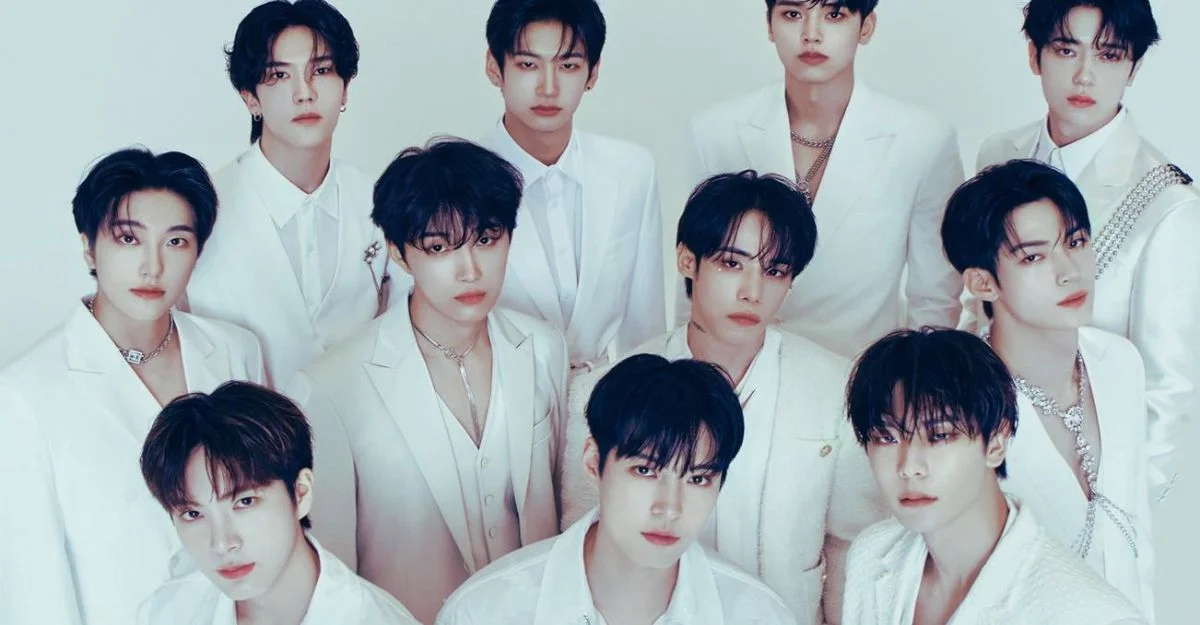Omega X is a South Korean kid bunch known for their dynamic exhibitions, flexible music, and moving excursion to progress. Appearing under Tower Diversion on June 30, 2021, with the small scale collection Vamos, the gathering immediately earned respect for their particular sound and constant quest for greatness. Containing 11 individuals, Omega X stands apart for remarkable setup of craftsmen recently appeared in different gatherings, making a charming story of persistence and renewed opportunities.
What is the meaning of OMEGA X?
The Members of Omega X
Omega X consists of 11 talented individuals, each bringing their own charm, talent, and experience to the group. The members include:
- Jaehan (Leader, Main Vocalist): Known for his powerful vocals and charismatic leadership.
- Hwichan (Vocalist): Brings emotional depth to the group’s ballads.
- Sebin (Rapper, Dancer): Known for his sharp dance moves and versatile rapping skills.
- Hangyeom (Rapper, Vocalist): Combines rap with soulful singing.
- Taedong (Vocalist, Dancer): Captures attention with his fluid dance moves and expressive voice.
- Xen (Vocalist): A vital vocal pillar of the group.
- Jehyun (Vocalist): Adds a unique tone to Omega X’s harmonies.
- Kevin (Rapper): A dynamic performer with a strong stage presence.
- Junghoon (Vocalist): Known for his bright energy and melodic voice.
- Hyuk (Maknae, Rapper): The youngest member, bringing a fresh and youthful vibe.
- Yechan (Vocalist, Dancer): A well-rounded performer contributing to vocals and choreography.
Each member’s prior experiences in other groups, such as 1TEAM, Seven O’Clock, and SNUPER, have shaped Omega X’s distinctive identity and contributed to their collective resilience.
The Concept and Vision of Omega X
The name “Omega X” symbolizes “infinite possibilities,” with “Omega” being the last letter of the Greek alphabet, signifying new beginnings despite seeming endings. The “X” represents the boundless potential of the group. Omega X aims to connect with fans globally through relatable music and meaningful interactions.
Their concept often revolves around themes of empowerment, self-expression, and resilience. This ethos resonates deeply with their fanbase, affectionately known as “FOR X,” who support the group with unwavering loyalty.
Discography: A Journey Through Their Music
Debut with Vamos (2021)
Omega X made a strong entrance into the K-pop scene with their debut mini-album Vamos. The title track, also named “Vamos,” blends Latin-inspired beats with K-pop energy, highlighting the group’s multicultural appeal.
What’s Goin’ On (2021)
Their second mini-album, What’s Goin’ On, solidified their growing reputation. The title track delivers a high-energy performance showcasing their dynamic choreography and vocal prowess.
Love Me Like (2022)
The group explored themes of passion and connection in their third mini-album, Love Me Like. The title track merges seductive melodies with a hypnotic beat, further demonstrating their versatility.
First Studio Album: Story Written in Music (2022)
This album marked a significant milestone, featuring tracks that delve deeper into personal stories and emotions. Songs like “Play Dumb” and “Dance with U” reflect their playful and heartfelt sides.
Challenges and Triumphs
Omega X’s process hasn’t been without challenges. The gathering confronted troubles in the exceptionally serious K-pop industry, intensified by the assumptions originating from their novel arrangement. In 2022, claims of abuse by their organization surfaced, which carried huge consideration regarding the gathering’s battles.
The individuals showed astounding flexibility by standing joined together and upholding for their privileges. This prompted a fight in court to end their agreement with Tower Diversion, in the long run acquiring freedom as specialists. Their assurance enabled them as well as motivated fans and the more extensive music local area.
Connection with Fans: FOR X
Omega X’s bond with their fans is a foundation of their prosperity. Through online entertainment stages, live streams, and fan occasions, the gathering guarantees they keep a nearby association with FOR X. Their ardent appreciation and receptiveness make a comprehensive local area where fans feel seen and appreciated.
The gathering’s fan administration stretches out past exhibitions. They effectively include fans in their excursion, from prodding forthcoming tasks to tending to their battles. This straightforward and veritable methodology hardens their steadfast fanbase.
The Future of Omega X
Omega X keeps on developing, both artistically and actually. The gathering’s attention on investigating different classifications, joined with their obligation to making significant substance, separates them in the steadily changing scene of K-pop. As free craftsmen, they have the opportunity to graph their own course and reclassify being a worldwide K-pop demonstration.
Impending ventures vow to exhibit their development and innovativeness, with plans for world visits, new music deliveries, and coordinated efforts. Omega X expects to push limits and leave an enduring effect on the business.
The Influence of K-pop on Global Culture
K-pop, short for Korean pop, has recently been experiencing a rapid increase in popularity all around the world. BTS, a South Korean boy group, for example, has charted nine number-one singles. They hold the best-selling singles record in the South Korean music industry. With their influence, K-poppers, or fans of K-pop, have spread all over the world. The popularity of K-pop is damaging the music industry in other countries. K-poppers or others who listen to K-pop music do not listen to many other music genres. The world of music, therefore, has become very narrow. It is taking longer for musicians to enter the market and develop. Therefore, many musicians and their fans suffer.
Amid the rapidly increasing influence of K-pop and K-culture, the South Korean government is making active use of K-pop to promote itself, and scholars are also examining K-pop. However, the current research is insufficient. It draws attention to the training of K-pop stars or transnational flows such as cultural globalization through consumption, but most research does not concern K-pop itself. We focus on the characteristics of K-pop and its elements and try to make up for this lack. In this work, however, we do not pretend to examine all the elements. First, as with popular music, it is difficult to define clearly the elements of K-pop, but we try to define it clearly. Second, we present K-pop singers, analysis of lyrics, and compositions. Third, under the influence of globalization, we describe the transnational flows of K-pop using concrete numerical data. In doing so, we develop a comprehensive and coherent definition of K-pop as a world music genre.
Origins and Evolution
K-pop has risen to international prominence and has grown into a multi-million-dollar industry backed by scores of management companies, record labels, and talented performers. How did this particular form of entertainment capture the hearts of billions of fans inside and outside of South Korea? And how does K-pop maintain and strengthen its position, influence, and fandom? In simple terms, K-pop is the music and performance of South Korean idols. K-pop expands into a range of different styles, from bubblegum pop and R&B to rap, hip-hop, rock, and electronica. Like any genre of music, K-pop has its own distinct music, fashion, dance, language, technology, and digital content.
In constructing the genealogy of K-pop, it is important to point out that the concept of a ‘pop star’ featured in Korea prior to the contemporary ‘idol.’ Classic popular music singers dominated pop genres until the 1980s, and the likes of Cho Yong-pil, who began his career in the 1970s, remain active today. As such, K-pop developed from both the modern Korean music known as trot and pop music. With music from the likes of Jang Yoon-jeong, K-pop is rooted in trot’s beat and emotion, while it is equally strong in popular ballads and dance music. Trot, or a hybrid of trot with other genres, is today consumed by a growing number of K-pop idols, games, dramas, and movies, and offers a platform for their massive popularity.
Key Characteristics
Characterized by multiple multimodal performances that feature audio, dance, visual content, and accouterments all at once, K-pop lyrics often tell narratives, deliver messages, or offer entertainment. K-pop fans recognize these various features simultaneously and assess them holistically. The pleasure of watching K-pop-related video content is not limited to K-pop songs. The video content may include music videos, episodes of reality programs, TV music shows, and award ceremonies. These contents provide K-pop fans with an opportunity to interact with K-pop, music, and K-pop stars. As a result, K-pop fans perceive music videos and related program content as significant parts of the K-pop genre.
K-pop’s sound and style originated from Western pop music, jazz, hip-hop, dance music, R&B, and electronic dance music, and its appearance is comparable to Western hit songs, which succeeded in turning their styles into a Westernized form. Furthermore, the visual and performance components of K-pop were honed through the fusion of Western pop’s primary color, eye-catching images, and active performances that K-pop introduced, and these components have become mainstream. The origin of K-pop comes from Western pop music, jazz, hip-hop, dance music, R&B, and electronic dance music, and its style and sound are comparable to Western singers. K-pop is essentially based on pop and dance music. It has all the features of pop music, with the core elements of catchy rhythm and pleasant melody. On the momentum of tempos, K-pop includes various electronic sounds, exceptional beats, clear lyrics, exotic sounds, vociferous piano, brass, and bold brass. The songs feature the use of synthetic rather than directly played instruments. K-pop has a rhythm pattern-based format; much of it uses common time, and the tempo is composed of 100 to 120 beats per minute. The typical verse-chorus arrangement is standard for K-pop.
Conclusion
Omega X is something other than a kid bunch; they are a demonstration of versatility, solidarity, and the groundbreaking force of fresh opportunities. From their unassuming starting points to becoming worldwide sensations, Omega X motivates fans overall to seek after their fantasies sincerely. With a consistently developing fanbase and a dream established in unfathomable potential, Omega X is without a doubt an awe-inspiring phenomenon in the K-pop world.

